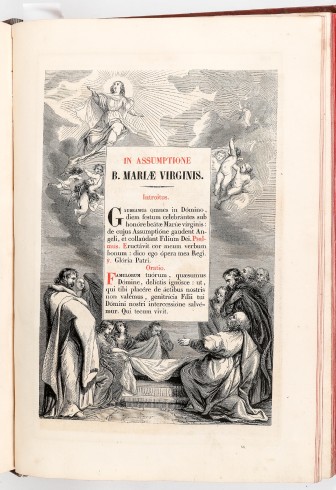Missal art is a favourite topic of mine and since today is the feast of the Assumption it seemed like a good day to consider how missal art has been approached within the 'modern' period -- i.e. the post incunabula era.
In the seventeenth and eighteenth century, we tend to run into depictions that were likely carved onto woodblocks to create the images in question, which creates a lively contrast between light and dark. From a subject matter point of view, these depictions were frequently either highly complex, including many scenes and decorative elements (as in the example below from 1620) or alternatively they were very emotive in the baroque sense, emphasizing emotion and movement. Here are three examples.
 |
| Missale Romanum, 1620 |
 |
| Missale Romanum, 1694 |
 |
| Missale Romanum, 1735 |
The nineteenth century continued on with this tradition, though technically speaking the depictions of that period tend more toward the very finely detailed plate etchings of the period. Because of this, the designs were frequently more 'subtle' or 'fine' in their overall appearance by comparison with their forebears from a century or two prior. That said, they still very much fall within the same sort of approach to missal art.
 |
| Missale Romanum, 1846 |
 |
| Missale Romanum, 1911 |
By the mid twentieth century we begin to see the rise of more 'primiitvist' depictions which came under the influence of certain 'archeologist' schools within the Liturgical Movement. This would eventually reach their apex in the rather abstractionist depictions that might be found in missals of the 1970's and 80's. This particular example below is of unknown date however, stylistically speaking, it certainly represents a style that was especially seen in the mid 20th century period, a combination of primitivism, medievalism and modernism (which was ultimately rooted back to primitivism).













